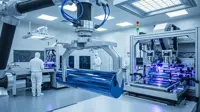Biologists and computer scientists create computational model of human tissue
10 Apr 2012
Computer scientists and biologists in the Data Science Research Center at the Rensselaer Polytechnic Institute at Troy, New York, have developed a rare collaboration between the two very different fields to pick apart a fundamental roadblock to progress in modern medicine.
Their unique partnership has uncovered a new computational model called ''cell graphs'' that links the structure of human tissue to its corresponding biological function. The tool is a promising step in the effort to bring the power of computational science together with traditional biology to the fight against human diseases such as cancer.
The discovery follows a more than six-year collaboration, breaking ground in both fields. The work will serve as a new method to understand and predict relationships between the cells and tissues in the human body, which is essential to detect, diagnose, and treat human disease. It also serves as an important reminder of the power of collaboration in the scientific process.
The new research led by Professor of Biology George Plopper and Professor of Computer Science Bulent Yener is published in the 30 March 2012, edition of the journal PLoS One in a paper titled, ''Coupled Analysis of in Vitro and Histology Tissue Samples to Quantify Structure-Function Relationship.'' They were joined in the research by Evrim Acar a graduate student at Rensselaer in Yener's lab currently at the University of Copenhagen. The research is funded by the National Institutes of Health and the Villum Foundation.
The new, purely computational tool models the relationship between the structure and function of different tissues in body. As an example of this process, the new paper analyzes the structure and function of healthy and cancerous brain, breast, and bone tissues.
The model can be used to determine computationally whether a tissue sample is cancerous or not, rather than relying on the human eye as is currently done by pathologists around the world each day. The objective technique can be used to eliminate differences of opinion between doctors and as a training tool for new cancer pathologists, according to Yener and Plopper. The tool also helps fill an important gap in biological knowledge, they said.
Every budding biologist is taught a central concept: there is a relationship between biological structures like cells or organs and their functions. This structure/function relationship is well understood at some levels.
For example, we know what individual brain cells are structurally comprised of and the functions they perform in the body. It is when you delve deeper into interactions between millions of different types of cells and dozens of specialized organs that our limited understanding of human biology is quickly brought to light.
''Previous biological analysis techniques simply ground up tissues and looked at things like gene expression. This is like looking at poll numbers after a vote. You don't know who voted for what or why, you only know who won the race,'' Plopper said. ''With this new analysis we can explain how individual cells function in the system while still focusing on the entire system as a whole.''
The ability to understand the complex relationship between cells in our tissues required an entirely new way to do biology, according to the scientists.
''We needed to take biology out of the Petri dish and microscope slide and lift it into a different space. We needed to integrate the interactions in the body on multiple scales,'' Yener said.
Yener and his computational counterparts did this by building a computational model using graph theory that linked several different biological data sets from Plopper and his biology counterparts. The biological data came from tissue samples physically removed from the human body and samples grown outside the body in the lab.
In the diagnosis of cancer, a pathologist removes a section of suspicious-looking tissue from a patient. The tissue sample is then sliced and stained for easier viewing and looked at through the age-old tool of biology, the microscope.






















